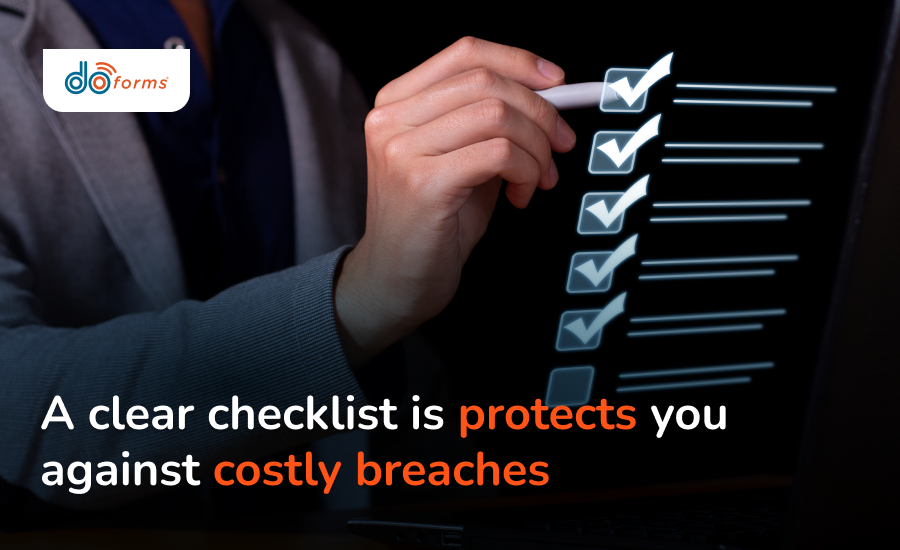
Cyber Security Checklist: Key Takeaways
- A cyber security checklist helps identify vulnerabilities, ensure compliance, train employees and reduce the impact of cyber threats
- It should include clear steps for user access, data protection, device and network security, employee training compliance and vendor risk
- To create an effective checklist: assign responsibilities, use digital tools and review regularly to reflect important updates
Cybercrime is projected to cost businesses over $10 trillion in 2025. The number is expected to increase to $15.6 trillion by 2029.
Even a single phishing email or cyber security attack can lock you out of your systems, leak sensitive data and bring your operations to a standstill.
In this guide, you’ll learn:
- What to include in a business-ready checklist
- How it protects your business
- What to consider when building your checklist with digital tools
Worried about missing security steps?
Try doForms For Free!
Cyber Security Checklist: What To Include
When you start mapping your audit process, you’ll quickly realize how much a detailed checklist simplifies the chaos.
We’ve prepared a template that you can copy into a digital form, print for manual use, or build into your workflow management system.
User Access & Authentication
- Enforce multi-factor authentication (MFA) for all user accounts.
- Apply a strong password policy, including requirements for minimum length, complexity and expiration.
- Disable or rename all default admin accounts.
- Conduct monthly reviews of user access rights.
- Deactivate inactive accounts that have not been used in the last 30 days.
Data Security
- Encrypt all sensitive data in transit: HTTPS, VPNs and secure email.
- Enable encryption for data at rest.
- Automate and test data backups regularly.
- Store backup data in offsite or cloud locations.
- Monitor and audit file access logs weekly.
Device & Network Security
- Install and update antivirus and firewall protection.
- Disable unused ports, services and protocols.
- Segment internal systems from guest and external networks.
- Implement VPN technology for all remote and mobile access.
- Enforce bring-your-own-device (BYOD) policies for mobile users.
- Isolate IoT devices from sensitive business networks.
Employee Training & Security Awareness
- Hold regular cyber security training sessions for all employees, for example, once or twice a year.
- Conduct quarterly phishing simulations to test awareness.
- Educate staff on how to identify and report suspicious activity.
- Implement and communicate clear procedures for reporting security incidents.
- Enforce access protocols for contractors and visitors.
Incident Response & Compliance
- Create a detailed incident response plan.
- Define and communicate breach response roles and responsibilities.
- Run biannual incident response drills to ensure readiness.
- Verify and document compliance with applicable regulations, whether HIPAA, CCPA or GDPR.
- Keep all system and security logs for required compliance periods
Third-Party & Vendor Security
- Keep an up-to-date list of all vendors and third-party service providers.
- Restrict and monitor vendor access to systems and data.
- Include data protection and breach notification clauses in all vendor contracts.
- Conduct annual vendor security assessments to verify compliance.
Why Businesses Need A Cyber Security Checklist
Cyber attacks impact more than just your IT department. They can be devastating to your whole operation, damaging customer trust and costing millions in recovery.
Imagine your relief when your team spots a phishing attempt before it spreads because everyone knew what to look for.
That’s the power of a well-designed checklist. You can use it proactively to identify critical systems and potential vulnerabilities so you can respond quickly and effectively to incidents.
By implementing a checklist, your team can spot red flags early, reduce human error, and be ready for every cyber event.

Simplify audits, protect sensitive data and respond to threats faster
How To Create A Cyber Security Audit Checklist With Digital Tools
A good cyber security checklist treats your business as a breathing organism, focusing on its infrastructure and workflows along with the ever-changing threats you may face. Here’s how to build one step by step:
Conduct A Risk Assessment
Identify what assets need protection. These can be employee data, financial records and intellectual property.
Document what threats may put them at risk (for example phishing, ransomware and insider abuse) along with the potential the attack may have on your business.
Categorize Your Checklist
Break your checklist into focused categories to ensure all areas are well covered. This can be:
- User access & authentication
- Data protection
- Network & endpoint security
- Employee training
- Incident response
- Compliance & legal
- Vendor/Third-party risk
Define Specific Controls
Under each category, list practical actions you plan to use to mitigate risk. These can be enforcing MFA, encrypting cloud backups, running phishing simulations, or reviewing access logs weekly.
Use precise language to create accountability. Avoid vague actions like “be aware of threats.”
Assign Responsibilities
Every item on your cyber security checklist must have an owner, whether IT staff, department heads, or outside vendors.
Define the person performing the task, its frequency, and the way to document and verify it. Be sure to define what actions should trigger escalation.
Choose A Format & Platform
Manual checklists get lost, causing compliance and audit headaches. Consider using a digital tool that supports mobile access and allows role-based permissions and automated reminders.
With digital tools, you’ll be able to build mobile-first checklists, assign tasks and receive real-time submissions with secure signatures.
This will ensure you have secure audit trails and can access your documents any time from any place.
Schedule Regular Reviews
Your business is constantly on the move. Your cyber security checklists should move with you. Review weekly for patches and backups and revisit monthly to verify access rights.
Set time for full checklist audit quarterly and perform annual review of cyber security policies and incident simulations.
Create Templates
Once you finalize your checklist, save it as a reusable template. Make sure to customize it by department, location (remote vs. HQ) and project phase.

With the right structure, protecting your business becomes part of your everyday operations
Create A Cyber Security Checklist With doForms
doForms is a mobile forms solution that makes cyber security checklists actionable and accessible.
Using doForms, you can create checklists by department, risk type or user level and automate assignments so users are notified when it’s time to complete a task.
The tool allows you to set rules so forms can’t be submitted unless all required fields are filled.
Once filled out, the results can be synced automatically, integrating with your data systems or dashboards for real-time tracking at any moment you need it.
Ready to reduce your security gaps?
Try doForms For Free!
Cyber Security Checklist FAQs
How often should I review our company’s cyber security checklist?
At minimum, review quarterly. Make sure to check critical items like patch updates on a weekly basis.
Can mobile teams use a digital checklist securely?
Definitely. Tools like doForms are built with security in mind. Using them, you can encrypt everything and control who sees what, even on mobile.
What happens if we miss a checklist item?
To flag missed items and notify your IT, create an automated workflow. This will ensure nothing important falls through the cracks
Is cyber security checklist useful for small businesses?
Absolutely. SMBs are vulnerable to attack because they typically have weaker defenses. A checklist creates a structured approach against threats without requiring full-time IT staff.
What else can I use doForms for?
Beyond security, doForms can help with inspections, work orders, maintenance checklists, time tracking, payroll forms and safety compliance.
What’s the best way to keep the checklist updated?
Review your cyber security checklist quarterly, especially after system changes, audits or incidents. Digital tools like doForms can help you track versions, automate alerts and assign recurring tasks.
How can I train staff to follow the checklist?
Train new hires during onboarding and run short refresher sessions every 6-12 months. Use simulations and quizzes to reinforce awareness and track completion digitally.
How do I prove cyber security compliance during an audit?
Keep digital records of checklist completions, incident logs, employee training and backup logs. With doForms, you can create timestamped audit trails that are easy to access and export when needed.
What if I don’t have an IT department?
If you don’t have a separate IT department, you can still implement basic controls using external support or tools that simplify the process. A cyber security checklist gives you a structured approach even if you outsource IT, protecting your business from common threats.
Do I need a different checklist If my business is distributed in different locations?
If your locations have different systems, staff roles or security risks, yes. You can create a core checklist and adapt it on a site-by-site basis using digital tools like doForms to streamline the process.
How long does it take to implement a cyber security checklist?
If you’re using digital tools, you can roll out a basic checklist within a day. Full implementation, including training and automation, may take a few weeks, depending on team size and system complexity.
Protect your business from cyber threats with doForms.
Book A Demo




